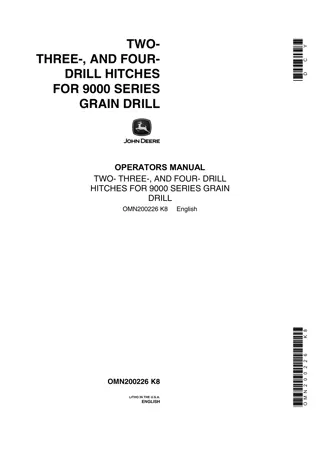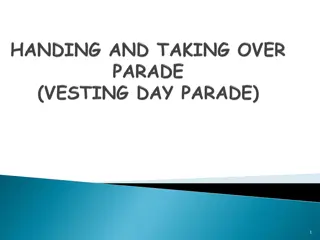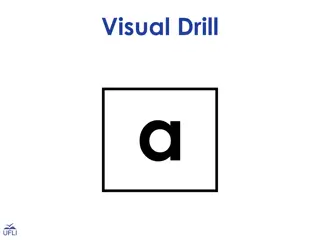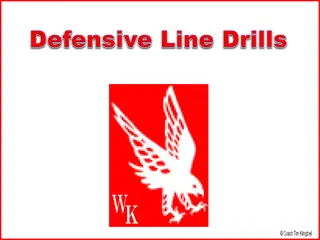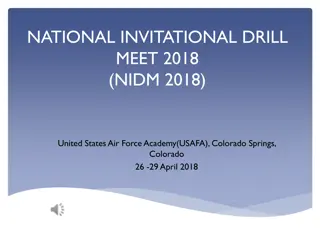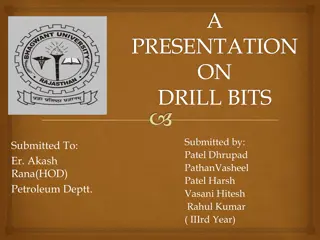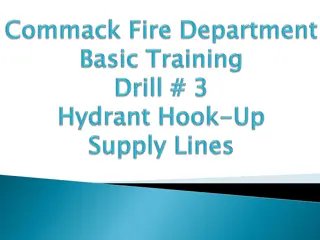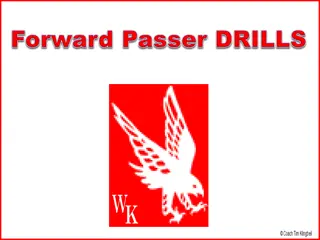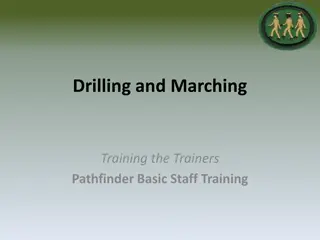Advanced Sword Drill Techniques for Officers
Sword Drill is an essential practice for officers using swords in parades. This paper covers the key elements of Advanced Sword Drill, including methods of wearing, drawing, and returning the sword, as well as using it during ceremonial events. Participants will learn about sword parts, proper techniques, and the significance of the sword in military tradition. Graceful movement, accuracy, and dignity are emphasized in this comprehensive guide.
Download Presentation

Please find below an Image/Link to download the presentation.
The content on the website is provided AS IS for your information and personal use only. It may not be sold, licensed, or shared on other websites without obtaining consent from the author.If you encounter any issues during the download, it is possible that the publisher has removed the file from their server.
You are allowed to download the files provided on this website for personal or commercial use, subject to the condition that they are used lawfully. All files are the property of their respective owners.
The content on the website is provided AS IS for your information and personal use only. It may not be sold, licensed, or shared on other websites without obtaining consent from the author.
E N D
Presentation Transcript
Introduction: Sword Drill is taught to Officers who bear and use swords on parades. The two main qualities that should be pursued in sword drills are a. Accuracy b. Graceful movement When drawn the sword is always held at the carry with two exception a. When Marshals are matching at ease b. When colours are sloped. When officers are ordered to FALL IN They will come to attention, draw their sword before stepping off. When ordered to FALL OUT , They will salute the senior officer, return their swords and fall in behind him. This lecture shall emphasize; parts of sword, methods of wearing sword, drawing and returning sword, sloping of sword, saluting at the halt with the sword and saluting with the sword while marching.
Aim: The aim of this paper is to acquaint officers or participants with the rudiments of Advanced sword drill.
Objectives: At the end of this paper, participants should be able to a. Know the different methods of wearing swords. b. Know the different methods of drawing and returning sword. c. Know how to use the sword during funeral parades. d. Know how to use the sword on mounted drill.
PARTS OF SWORD a. Tip b.Blade c. Pummel d.Hilt e. Handle
Concept Officers are known by the sword they carry , swords in drill are only carried by officer, it s a sign of dignity and carriage for the cadre, its only commissioned officers that are allowed to draw sword while on parade. Senior marshals can only wear the sword but can t draw the sword while on parade.
METHOD OF WEARING SWORD. Sam Browne belt: This is hung vertically with the hilt facing to the front and the pummel in line with the top of the Sam Brown. As the sword hilt is already facing the front, no assistance is required by the left hand to turn the sword to the front.
Add it to your favourites to revisit it later. METHOD OF WEARING SWORD CONTD Slung sword: The sword is hung on the belt hook, hilt to the rear behind the left elbow, shoe of the scabbard to the front. The method of drawing and returning is given in subsequent paragraphs. Anodized Sword Sling for Officer's Sword
METHOD OF WEARING SWORD CONTD Trailed sword a. Wearing of sword. The sword is worn in this position by mounted officers, when they are dismounted; the shoe of the scabbard when the sword is not drawn, rests on the ground behind the left heel; the hand holds the handle of the sword, back of the hand to the left, fingers curled around the handle, thumb around the right side. The sword handle is forward of the body. Image result for mounted sword drill Related image
DRAW SWORD In drawing of sword for the purpose of Drill, the movements are basically divided into three steps i.e. a. Miss b. Recover c. Carry Note: Drawing of sword must be from attention position.
Position of Attention For the various methods of wearing swords the position of attention will be. a. Sam Browne belt: The position of attention, except that the scabbard is held with the left hand, the left arm straight, thumb curled around the front back of the hand to the left, forefinger running down the left side, remaining fingers curled around the back. (In some Corps and Regiments the left arm is bent outside the hilt). b. Slung Sword: The position of attention with the hilt of the sword behind the left elbow. c. Trailed Sword: The position of attention except that the left hand holding the sword in its scabbard is slightly forward of the left thigh.
Draw Swords DRAW SWORDS ONE! a. Grasp the top of the scabbard with the left hand and turn it so that the hilt of the sword is pointing to the front-back of the hand to the left, fingers curled round the scabbard ,thumb on the right side, left elbow to the rear. At the same time take the right hand across the body and grasp the handle of the sword, back of the hand to the rear.
Draw Swords Cont. DRAW SWORD- MISS b. Draw the sword with the right hand until the forearm is horizontal and as close to the body as possible with the pommel of the sword in line with the shoulder. Note: All these movements are done in sequence without pause.
Draw Swords Cont. DRAW SWORD- RECOVER SQUAD-TWO! Draw the sword sharply forward and upwards and assume the position of the Recover with the tip of the sword uppermost edge to the left, hilt in line with the mouth, fingers curled around the handle thumb pointing upwards, back of the hand to the front, forearm and elbow close to the chest At the same time release the scabbard and adopt the position of attention with the left hand.
Draw Swords Cont. DRAW SWORD- CARRY d. SQUAD-THREE! Bring the sword to the right side and assume the position of the Carry with the blade vertical and edge to the front; change the grip during this movement curling the fingers lightly on the forefinger and thumb, forearm horizontal, elbow close to the side. Note: To ensure that the sword is upright on the march it should be held lightly balanced and gripped by the thumb and fore finger, the finger extended giving balance.
Return Swords a. RETURN SWORDS-ONE! 1. With the right hand bring the sword across the body, keeping it vertical, until the hilt is to be left of and in line with, the left shoulder. The edge is to the left and right elbow is raised. At the same time seize the scabbard with the left hand and turn it clockwise through 180 degrees with the fingers curled around the top, the thumb on the inside and the elbow to the rear. 2. Allow the point of the sword to drop to the rear until it is parallel to the left side of the body. Allow the handle to rotate through the fingers so that the hilt is facing the front. When the sword point touches the scabbard, raise the sword and with the fingers of the left hand, guide it into the mouth of the scabbard.
Return Swords Cont. Force these sword into scabbard to the position of Draw Swords One b. SQUAD-TWO! Place the right hand, with the palm downwards the fingers curled, on top of the pommel and with the left hand still holding the scabbard, force the sword onto the scabbard, with the right forearm horizontal and elbow raised. c. SQUAD-THREE! Return both hands to the side. As left hand returns to the side give the scabbards a flick to ensure that the sword twists back to the position of attention.
SLOPE SWORD Slope Swords SLOPE SWORDS! Done only from the carry. Allow sword to drop back on to the right shoulder, the forearm remains horizontal, the fingers rest on the handle and the little finger goes behind the handles.
Stand at Ease (Sword Drawn) STAND AT-EASE! Bend the left knee and slope the sword. Note: The left hand remains to the side except with the trailed sword. Stand Easy (Sword Drawn) SWORD-EASY! Allow the point of the sword to fall forward and to the left so that it is placed to the ground between the feet in line with the tips of the toes. The Hilt faces right and the hand is cupped on top of the pommel. Place the left hand on top of the right hand and relax the body.
STAND AT EASE- WET GROUND DRY GROUND
Saluting (At the Halt) Saluting (At the Halt) a. SALUTE TO THE FRONT-ONE! Bring sword to the recover. b. SQUAD-TWO! Lower the sword swiftly to the right side so that the right arm is straight the edge of the sword is to the left, the point is 12 inches from the ground and in front of the right shoulder. The thumb is flat on the side of the handle and the fingers grip the handle. The hilt is just behind the right thigh. c. SQUAD-THREE! Bring the sword to the Recover. d. SQUAD-FOUR! Return to the carry. Note: 1. Marshals with the exception of Chief Inspector, on Trooping the Colour Parades, do not salute with the sword. Carry swords is the compliment given. 2. Officer (Recipient of Salute) will salute when on saluting officer complete action on Squad Two Remain in position of salute to drop hand simultaneously as saluting officer completes action on squad Four .
SALUTE TO THE FRONT- SIDE VIEW SALUTE TO THE FRONT
Saluting on March in Slow Time The movement starts from the carry, as the left foot comes to the ground after the word of command Eyes Right or Left it lasts over four pace, finishing on the right foot. There is no pause between the movement, which will be carried out as one graceful gesture, with the hand moving at about the same speed as the feet in all movements except the first one. a. SALUTING BY NUMBERS, SALUTE TO THE RIGHT-ONE Shoot the right arm out above shoulder high so that the pommel of the sword is in line with the top of the shoulder. The sword is square off to the right, blade vertical edge to the right. At the same time turn the head and eyes to the right (or left). b. SQUAD-TWO! Keep the blade vertical and hand and elbow, at the same height as for the first movement. Bring the sword round in a circular sweep across the body so that the pommel of the hilt comes to the point of the left shoulder. The elbow is kept level with the shoulder and the thumb remains round the handle. c. SQUAD_THREE! Without a pause, continue the sweep, the sword passing through the position of the recover, until the pommel is in front of the point of the right shoulder. Elbow shoulder high, upper arm horizontal, hand in line with the mouth. d. SQUAD-FOUR! Lowering the elbow to the side and changing the grip so that the thumb points up the side of the handle, lower the sword to the position of the salute.
Saluting On March In Slow Time Cont. The timing is as follows: 1. Left foot comes to the ground shoot the right arm out 2. Right foot comes to the ground sword at the left shoulder. 3. Left foot come to the ground sword at the right shoulder. 4. Right foot comes to the ground point lowered to the salute. e. EYES-FRONT! Given as the right foot comes to the ground. As the next left comes to the ground, turn the head and eyes to the front and at the same time bring the sword to the position of the recover, elbow close to the side. As the left foot next comes to the ground bring the sword down to the position of the carry.
SALUTING WITH SWORD- SLOW MARCH (STEP ONE) SALUTING WITH SWORD- SLOW MARCH (STEP TWO)
SALUTING WITH SWORD- SLOW MARCH (STEP THREE) SALUTING WITH SWORD- SLOW MARCH (STEP FOUR)
Saluting on the March in Quick Time The sword will be retained at the carry. The head and eyes will be turned off on the word of command given to the troops.
Mounted Sword Drill To Draw Swords a. DRAW SWORDS ONE! Bring the right arm across body, over the bridle arm, and draw the sword until the hilt rests on the bridle arm. If required put the right hand through the sword knot and take two or more turns to secure it. Grasp the handle, with the forearm and elbow close to the body. Body is upright and shoulders are square to the front. b. SQUAD-TWO! Draw the sword sharply and bring it to the position of the recover. c. SQUAD-THREE! (Position of the Carry). Force the sword down to the right thigh so that the upper arm is vertical, elbow close to the side, wrist resting on the thigh, blade vertical, edge to front, hilt resting on the top of the hand, first three fingers gripping the handle, little finger behind to steady it, pommel pressed against the thigh.
Mounted Sword Drill Cont. Slope Swords SLOPE SWORDS! Raise the forearm until it is horizontal, hand in front of the elbow and lower the sword on to the shoulder as already detailed. Sit At Ease SIT AT EASE! (From the slope only). place both hands on the front of the saddle, right over left, without removing the sword from the shoulder. Return Swords a. RETURN SWORDS ONE! As already detailed passing the right arm over the bridle arm. b. SQUAD-TWO! As already detailed (if necessary clearing the hand from the sword knot) c. SQUAD-THREE! Return the right hand to the side. Proving With the sword at the slope a man ordered to prove will come to the carry. On the command As you were he will slope swords.
Funeral Exercises With Sword Funeral exercise with swords are done as follows: a. Processional troops will march with their sword reversed, but should reverse sword before stepping off. b. When marching in quick time the left hand will be removed from the sword and the arm swung. The sword hilt will be allowed to drop, bringing the sword to horizontal position under the right armpit.
Swords The Reverse from the Carry: This movement will be done when soldiers reverse from the shoulder. a. REVERSE ARMS-ONE! Force the sword under the right arm pit, edge uppermost, by twisting the wrist and dropping the point of the sword to the left front; hilt on top and in front of the right shoulder, fingers of the right hand are together and straight and to the right of handle, thumb to the left, back of the hand to the right, right elbow against the side and the sword at an angle of 45 degree. b. SQUAD-TWO! Seize the blade with the left hand behind the back, in line with waist belt, back of the hand underneath. Note: The reverses from the carry will be done working on the first and third movement of the rifles.
Change swords from the reverse a. CHANGE ARMS-ONE! Return the left hand to the side and at the same time change the grip of the right hand by placing it underneath the sword handle, thumb on the right; the hilt to the front. b. SQUAD-TWO! Pass the sword across the body into the left hand, return the right hand to the side, rotate the hilt to the right and force the sword under left armpit, thumb to the left fingers curled around the handle, hilt uppermost. c. SQUAD-THREE! Seize the blade with the right hand behind the back, back of the hand underneath, sword at an angle of 45 degrees. Change the position of the left hand on the handle, so that the fingers are together and straight on the left and the thumb is on the right with the back of the hand to the left.
To Rest on Swords Reversed from the Present To Rest on Swords Reversed from the Present a. REST ON YOUR ARMS REVERSED-ONE! Bring the sword to the recover from the present. b. SQUAD-TWO! Allow the point of the sword to fall forward and place the point between the feet in line with tip of the toes, edge to the right, rotating the hilt to the right. At the same time move the grip of the right hand so that it is resting on the pommel. Keep the elbow raised. This movement is done to a count of eight seconds. c. SQUAD-THREE! Place the left hand on top of the right with the elbow raised. d. SQUAD-FOUR! Drop the elbows to the sides. e. SQUAD-FIVE! Lower the chin on to the breast. Note: All these movements are done with dignity. The third, fourth and fifth movement are not hurried.
Present from Rest on Arms Reversed Before this movement is done the party must be called to attention on which command the head and the elbows are raised simultaneously. a. PRESENT ARMS-ONE! Left arm moved sharply to the side through shortest route. b. SQUAD-TWO! Twist the sword clockwise so that the hilt is facing left and thumb pointing down. c. SQUAD-THREE! The sword is moved round the right thigh to the side through the shortest route. The tip of the sword 12 inches above the ground. Note: This is the only exercise when present arms is done without going through the recover .
CONCLUSION Military and paramilitary parades would be incomplete without the use of the sword. All officers are known by the sword they carry, though a weapon it also serves as an instrument to showcase dignity, valour and pride in time of peace, as part of dressing, ceremonial parades and celebrations.


